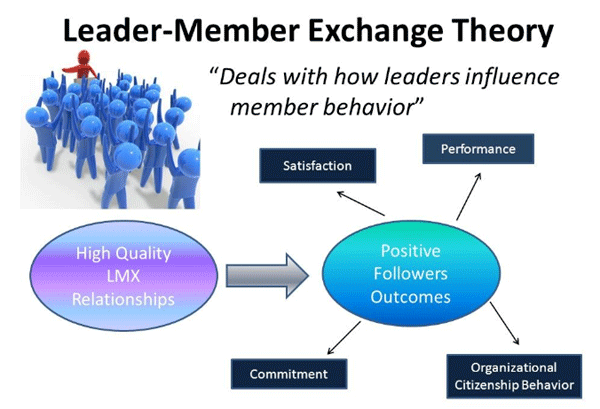
The leader–member exchange theory LMX ,is a relationship-based approach to leadership that focuses on the two-way relationship between leaders and followers.Both social exchange and role theory perspectives underpin the evolution of LMX theory and research
According to this theory, leadership resides in the quality of the exchange relationship developed between leaders and their followers. High quality exchanges are characterized by trust, liking, and mutual respect, and the nature of the relationship quality has implications for job-related well-being and effectiveness of employees
LMX Theory challenges the notion that Leaders should interrelate with and have the same level of association ship with every member of the group.
Organisation’s business processes are actually made up activities involving multiple interactions among leaders and members toward’s executing task’s of various degree with multiple skill sets among its members and hence the – quality of interaction , relationship and alignment – between the Leader and his members assumes focus in this theory.
LMX theory acknowledges the issue that, Leaders and members as humans ,are vastly different and unique in their styles and behavioral traits and hence differential interaction is inevitable as humans, and also Organisations exists amidst the society which is made up of people from the diverse groups and hence differential interfaces are natural. Also observation of leadership behavior suggests that leader’s orientation is not the same towards all members.
Leader-member exchange (LMX) Dansereau, Graen, and Haga (1975) first introduced the notion of LMX (originally called “vertical dyad linkage”) as a means to recognize that leaders adopt different leadership styles to form relationships with individual subordinates based on their different needs, attitudes and personalities.
LMX suggests that leaders and subordinates develop unique dyadic relationships over time as they influence each other and negotiate their roles in their ongoing interactions (Dansereau et al., 1975).
LMX can be viewed as either a process of reciprocal social exchange (Blau, 1964) or as a continuous role making process.
The quality of the relationship is reflected by the degree of mental alignment to the leaders informal working norms.
LMX – High quality interaction helps in High retention, High engagement, Superior ( in-group)team performance .
Leaders should endeavor to enlarge, include and create a feeling of more inclusiveness among team members being part of the IN- GROUP through versatile interaction styles with members individually .
In other words , this relationship phenomena / sensation ,can be described as personal rapport and mutual admiration.
Leaders Orientation and understanding of Transactional Analysis will be of help in this process.

 Follow
Follow